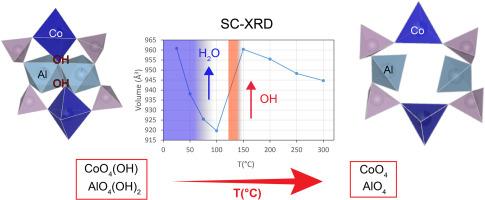一种新型共取代磷酸铝(CoAPO-14)的晶体结构和热行为
IF 4.7
3区 材料科学
Q1 CHEMISTRY, APPLIED
引用次数: 0
摘要
含有二价原子的开骨架磷酸铝(AlPO4)因其增强的氧化还原、酸性和磁性而受到关注。我们合成了一种新的含有MO5单元的混合多面体框架共取代AlPO4-14。化合物(H2O)1.9(C3H12N2)[Co1.10Al2.98P4O16OH]在P-1空间群中结晶,其中Co2+在三角-双棱锥几何结构中主要占据五重配位。通过原位跟踪结构变化作为温度的函数,我们可以确定结构转变,导致在100至150°C之间形成具有AFN拓扑的连续四连接网络。这是由属于框架的OH基团的丢失引起的,这些OH基团最初与CoO5和AlO6单位协调。这种转变伴随着单位胞体积的突然膨胀,其在150℃时的体积大约等于在室温下测量的体积。该结构在300°C时开始失去结晶度。本文章由计算机程序翻译,如有差异,请以英文原文为准。

A new Co-substituted aluminophosphate (CoAPO-14): crystal structure and thermal behaviour by in situ single crystal X-ray diffraction
Open-framework aluminophosphates (AlPO4) containing divalent atoms are of interest because of their enhanced redox, acidic, and magnetic properties. We have synthesized a new Co-substituted AlPO4-14, with a mixed polyhedral framework containing MO5 units. The compound (H2O)1.9(C3H12N2)[Co1.10Al2.98P4O16OH] crystallizes in P-1 space group, where Co2+ mostly occupies a five-fold coordinated site in a trigonal-bipyramid geometry. By tracking in situ the structural modifications as a function of temperature, we could identify a structural transformation, which lead to the formation of a continuous four-connected net with AFN topology, between 100 and 150 °C. This is induced by the loss of OH groups belonging to the framework and originally coordinated to the CoO5 and AlO6 units. This transformation is accompanied by a sudden expansion of the unit-cell volume, which at 150 °C is approximately equal to that measured at room temperature. The structure starts loosing its crystallinity at 300 °C.
求助全文
通过发布文献求助,成功后即可免费获取论文全文。
去求助
来源期刊

Microporous and Mesoporous Materials
化学-材料科学:综合
CiteScore
10.70
自引率
5.80%
发文量
649
审稿时长
26 days
期刊介绍:
Microporous and Mesoporous Materials covers novel and significant aspects of porous solids classified as either microporous (pore size up to 2 nm) or mesoporous (pore size 2 to 50 nm). The porosity should have a specific impact on the material properties or application. Typical examples are zeolites and zeolite-like materials, pillared materials, clathrasils and clathrates, carbon molecular sieves, ordered mesoporous materials, organic/inorganic porous hybrid materials, or porous metal oxides. Both natural and synthetic porous materials are within the scope of the journal.
Topics which are particularly of interest include:
All aspects of natural microporous and mesoporous solids
The synthesis of crystalline or amorphous porous materials
The physico-chemical characterization of microporous and mesoporous solids, especially spectroscopic and microscopic
The modification of microporous and mesoporous solids, for example by ion exchange or solid-state reactions
All topics related to diffusion of mobile species in the pores of microporous and mesoporous materials
Adsorption (and other separation techniques) using microporous or mesoporous adsorbents
Catalysis by microporous and mesoporous materials
Host/guest interactions
Theoretical chemistry and modelling of host/guest interactions
All topics related to the application of microporous and mesoporous materials in industrial catalysis, separation technology, environmental protection, electrochemistry, membranes, sensors, optical devices, etc.
 求助内容:
求助内容: 应助结果提醒方式:
应助结果提醒方式:


